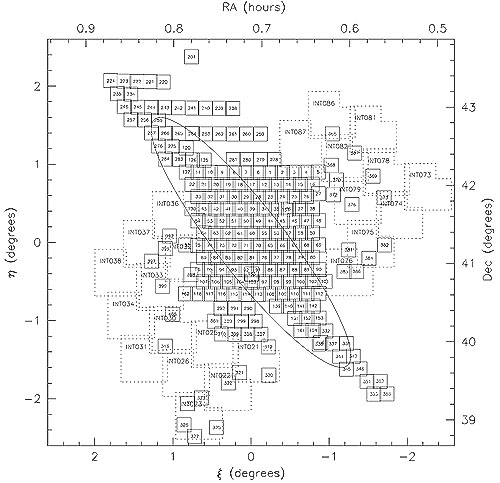Observations of the distribution of stellar velocities in the Solar neighbourhood of the Milky Way reveal a wealth of complex structure. For a dynamical entity such as the Galaxy, this structure is as fundamental as the spatial arrangement of its stars,
and should contain a mass of information as to the system's current state, as well as archaeological clues as to how it formed. Unfortunately, such data from a single locality are difficult to interpret in terms of the global structure of the Galaxy.
Although kinematic observations of more distant stars in the Milky Way have been made, the complexity of disentangling the geometry of our own Galaxy makes such data difficult to interpret.
An obvious next target is therefore the Milky Way's nearby sister system, the Andromeda galaxy, M31.
However, studying the detailed kinematics of stars in even a nearby external galaxy is quite challenging. In fact, the first problem arises from its very nearness: M31 subtends such a large angle on the sky that many spectroscopic
instruments are unable to survey the whole system within a realistic time. Further, even at what by extragalactic standards is the very modest distance, obtaining high-quality spectra of individual stars is challenging; it is only relatively recently that the
requisite observations of even bright red giant branch (RGB) stars have been made.
Planetary nebulae (PNe) have long been recognized as a potentially simpler dynamical tracer of the stellar population. Stars evolve very rapidly but quite gently from the RGB phase to become PNe,
so the kinematics of these two populations should be essentially identical. Further, the presence of strong emission lines in PNe make them quite easy to identify, and render the measurement of their Doppler shifts fairly trivial.
More than 20 years ago, astronomers reported on kinematic measurements of 34 PNe in M31, but it was not until recently with the development of wide-field multiobject spectrographs that it has become possible to start to
obtain the large sample necessary for dynamical studies. Even with such instruments, these studies involve both narrow-band imaging to identify candidate PNe and subsequent spectral follow-up, and this complex two-stage process has limited
astronomers' enthusiasm for such projects. However, the recently commissioned Planetary Nebula Spectrograph (PN.S) on the WHT has reduced this process to a single stage, simultaneously identifying PNe and measuring their velocities.
Astronomers have therefore used this instrument to carry out a deep kinematic survey of PNe over ~6 deg2, covering the bulk of M31's visible area. They obtained a catalogue of positions, magnitudes and velocities for 3300
emission-line objects found by the PN.S. Of these objects, 2615 are found likely to be planetary nebulae (PNe) associated with M31. With the exception of the very central, high surface brightness region of M31, this survey is complete to a magnitude
limit of m5007~23.75, 3.5 mag into the PN luminosity function.
The calibrated data were checked for internal consistency and compared with other catalogues, in particular one made from
observations previously obtained using Autofib2 on the WHT and narrow-band imaging with the Wide Field Camera on the WHT. This another survey had produced a sample of 723 PNe in the disc and bulge of M31. Velocities were determined using the [O III] λ5007
emission line. Rotation and velocity dispersion were measured to a radius of 50 arcmin (11.5 kpc), the first stellar rotation curve and velocity dispersion profile for M31 to such a radius. The kinematics were consistent with rotational support at radii well beyond
the bulge effective radius of 1.4 kpc, although the data beyond a radius of 5 kpc were limited.
The luminosity function of the surveyed PNe is well matched to the usual smooth monotonic function. The only significant spatial variation in the luminosity function occurs in the vicinity of M31's molecular ring, where the luminosities of PNe on the near side
of the galaxy are systematically ~0.2 mag fainter than those on the far side. This difference can be explained naturally by a modest amount of obscuration by the ring.
The absence of any difference in luminosity function between bulge and disc suggests that the sample of PNe is not strongly populated by objects whose progenitors are more massive stars. This conclusion is reinforced by the excellent agreement between the number
counts of PNe and the R-band light.
The number counts of kinematically selected PNe also allow to probe the stellar distribution in M31 down to very faint limits. There is no indication of a cut-off in M31's disc out to beyond four scalelengths, and no
signs of a spheroidal halo population in excess of the bulge out to 10 effective bulge radii.
A preliminary analysis of the kinematics of the surveyed PNe shows that the mean streaming velocity of the M31 disc PNe is found to show a significant asymmetric drift out to large radii.
Their velocity dispersion, although initially declining with radius, flattens out to a constant value in the outer parts of the galaxy. There are no indications that the disc velocity dispersion varies with PN luminosity, once again implying
that the progenitors of PNe of all magnitudes form a relatively homogeneous old population. The dispersion profile and asymmetric drift results are shown to be mutually consistent,
but require that the disc flares with radius if the shape of its velocity ellipsoid remains invariant.
 |
Fields observed in M31. The small square fields are PN.S field locations; the larger fields with dotted outlines are the INT WFC fields. The ellipse marks a 2° (27.4 kpc) disc radius.
(Extracted from Merrett et al., 2006, MNRAS, 369, 120). [ JPEG | TIFF ]
|
References:
- C. Halliday et al., 2006, "Planetary nebula velocities in the disc and bulge of M31", MNRAS, 369, 97.
- H. R. Merrett et al., 2006, "A deep kinematic survey of planetary nebulae in the Andromeda galaxy using the Planetary Nebula Spectrograph", MNRAS, 369, 120.

